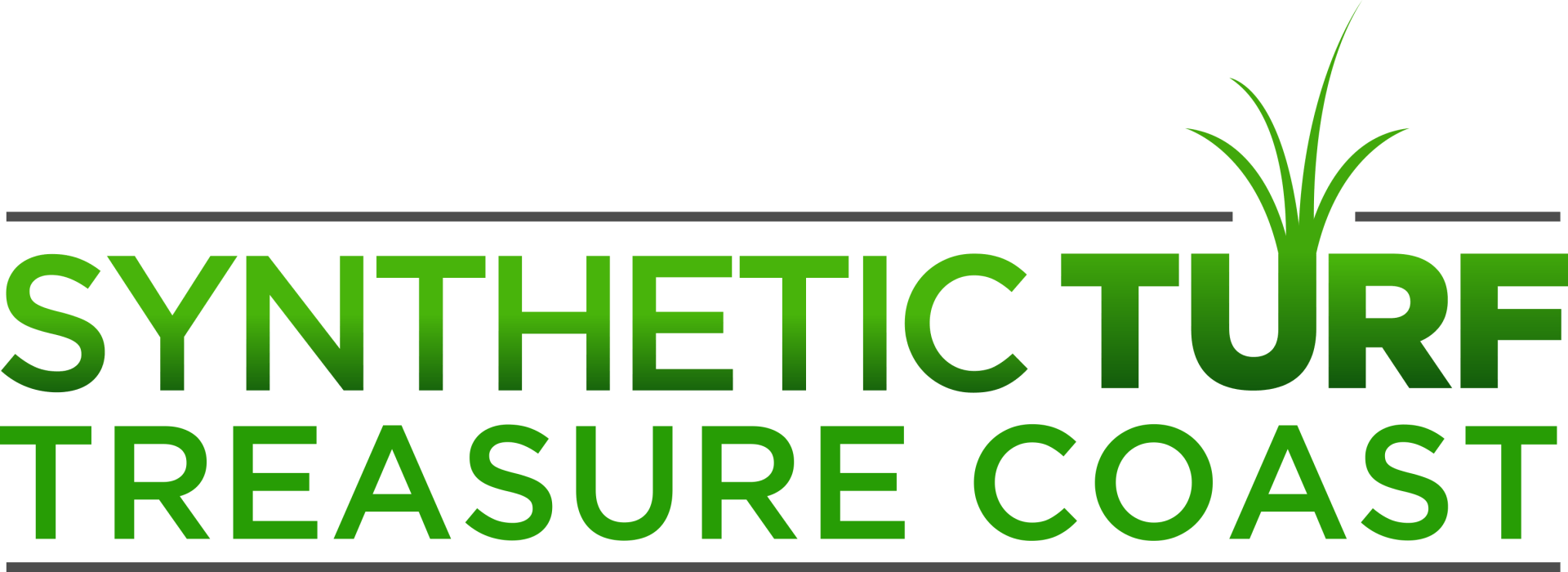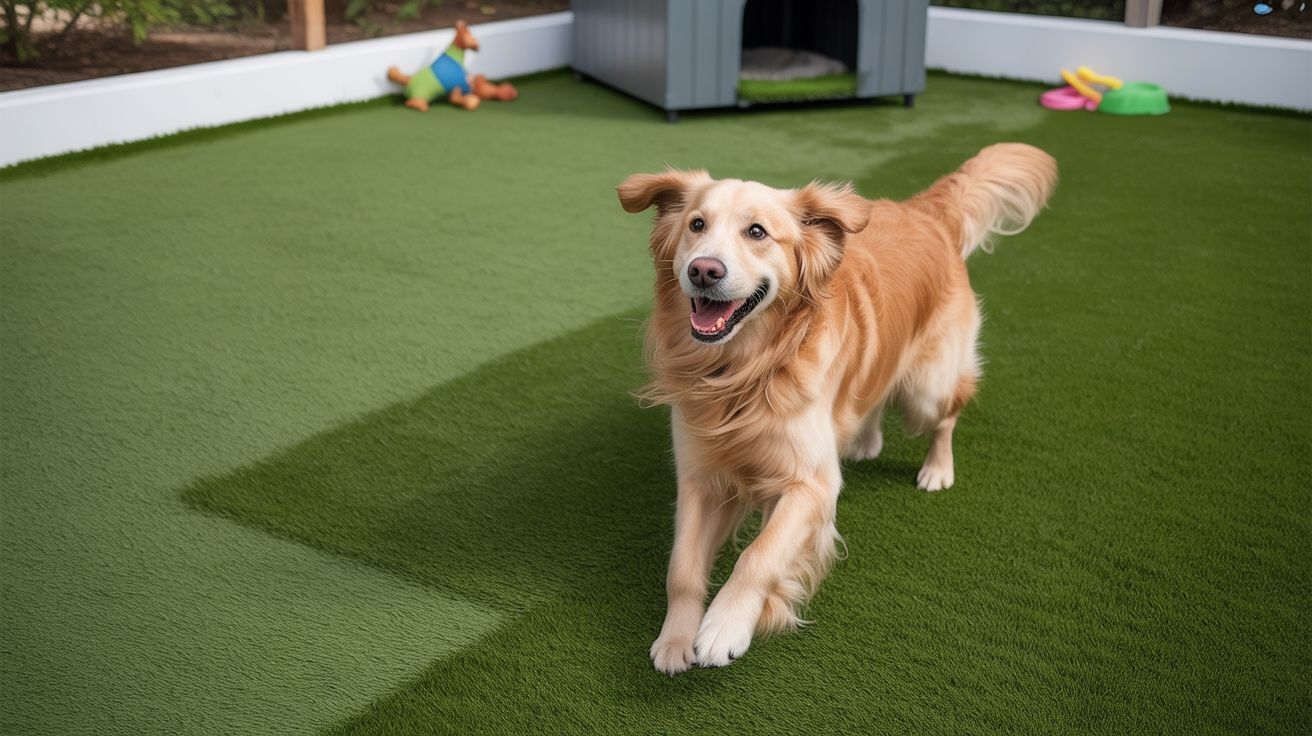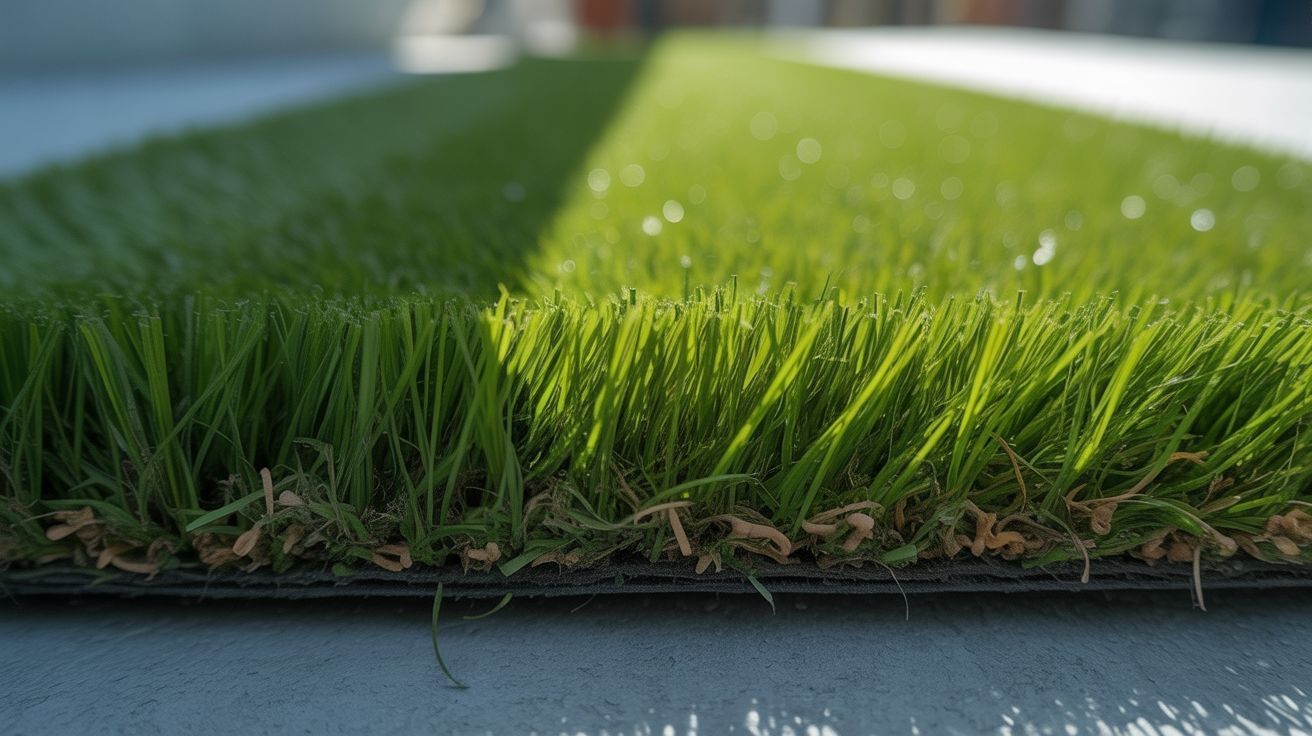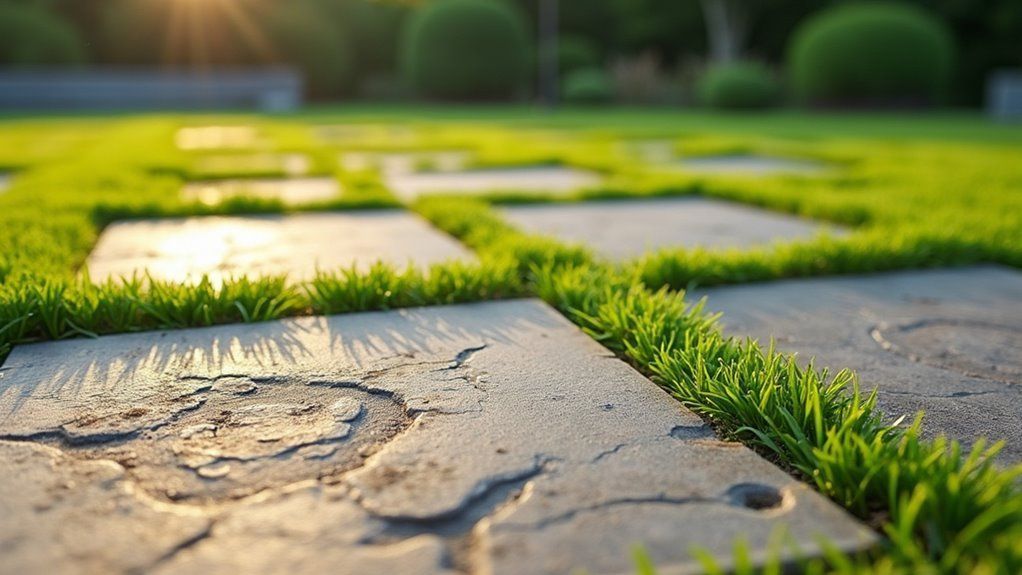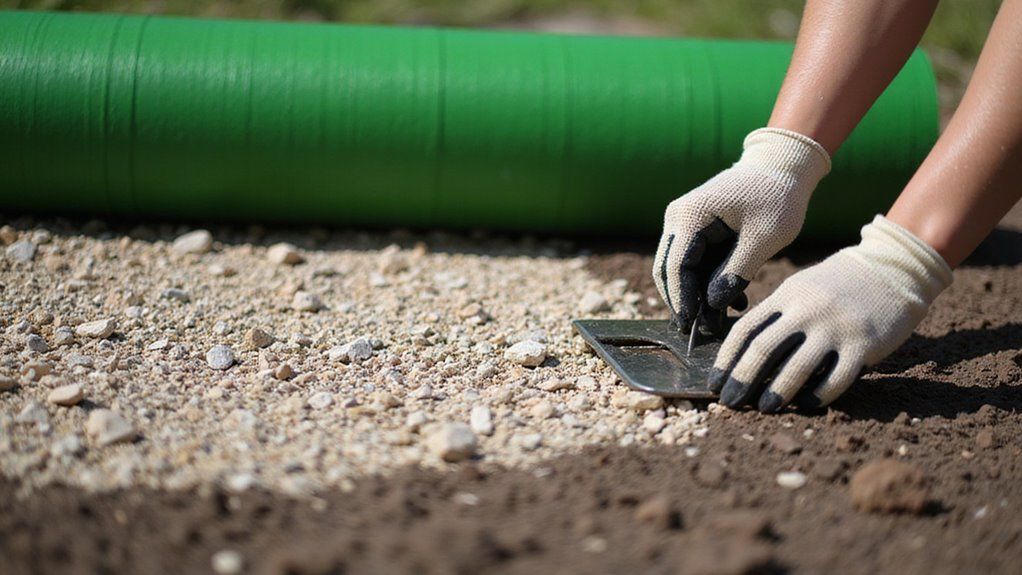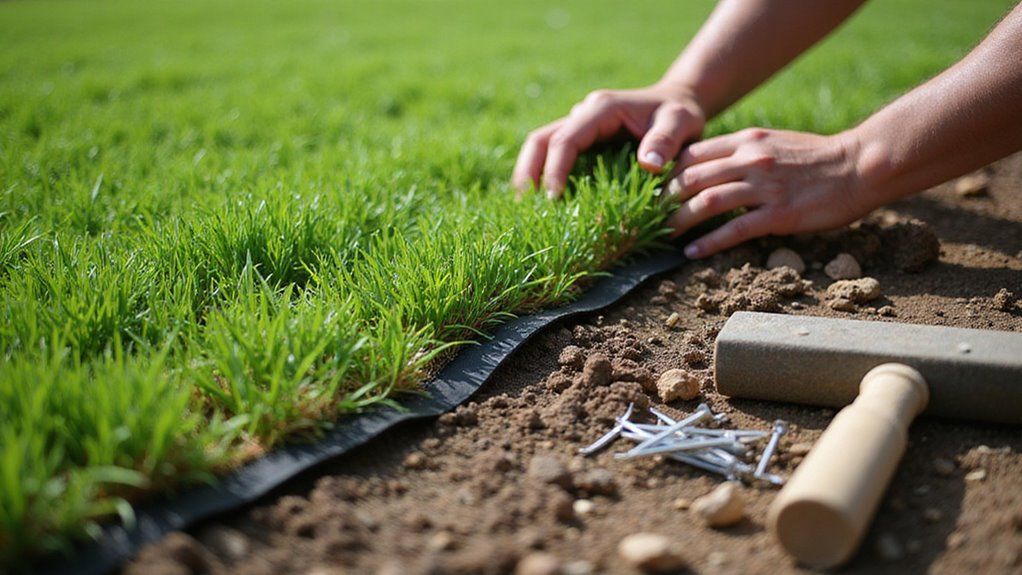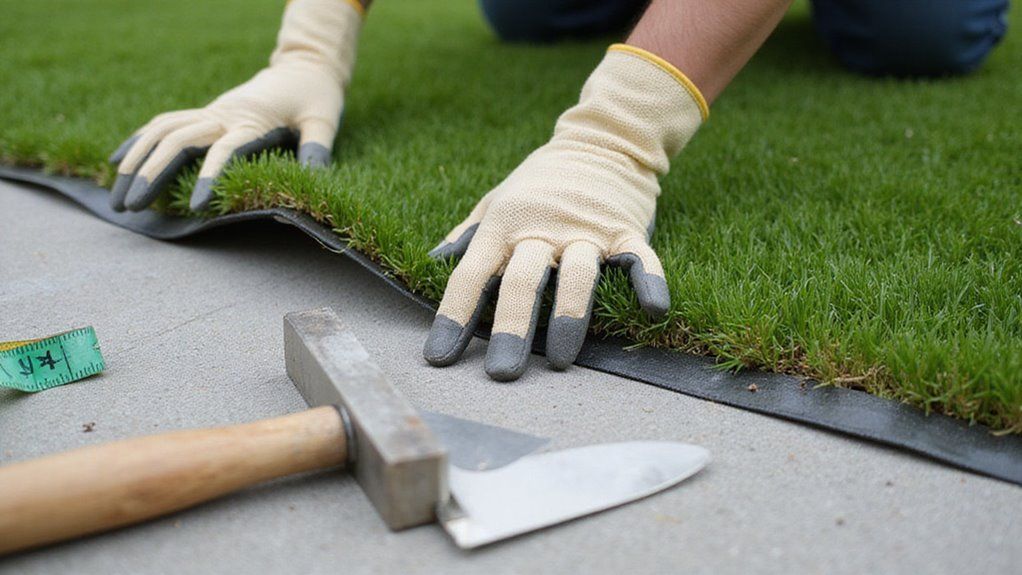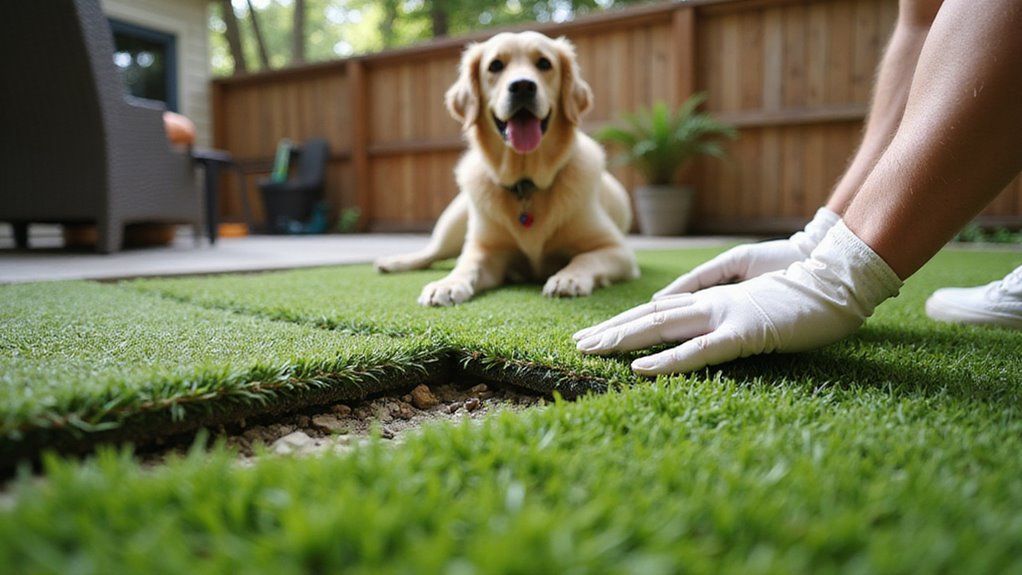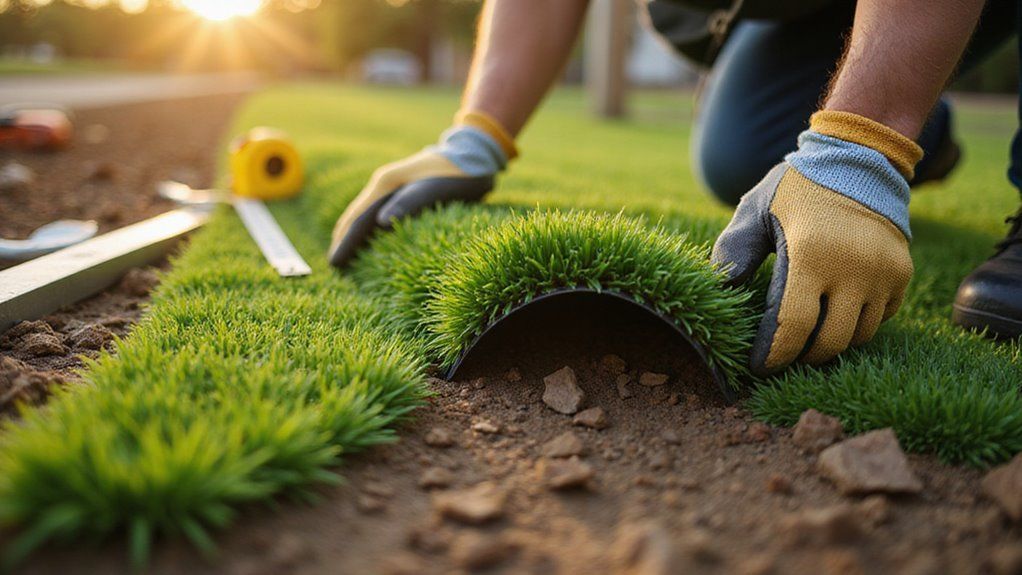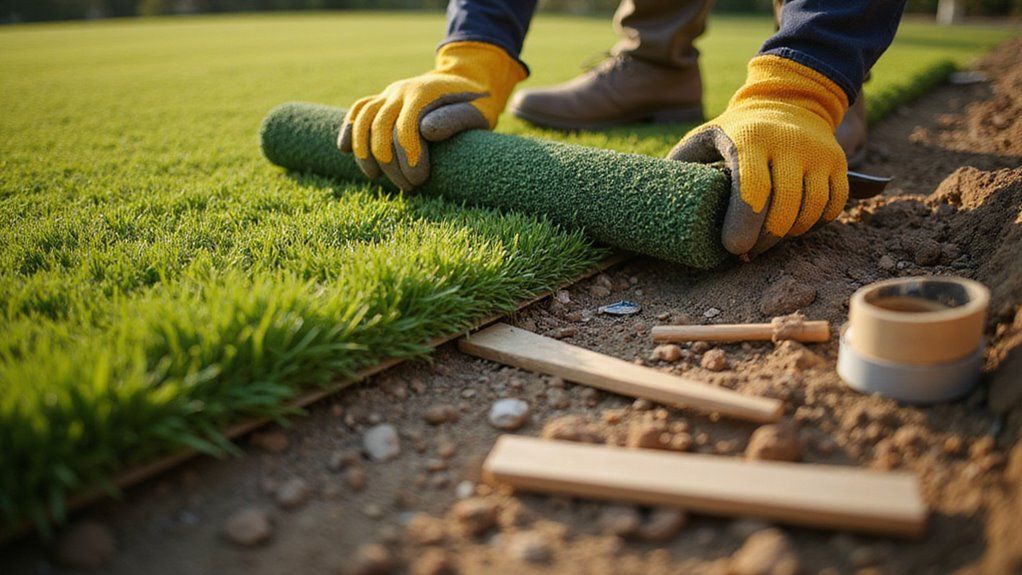How Long Does It Take to Install Artificial Grass
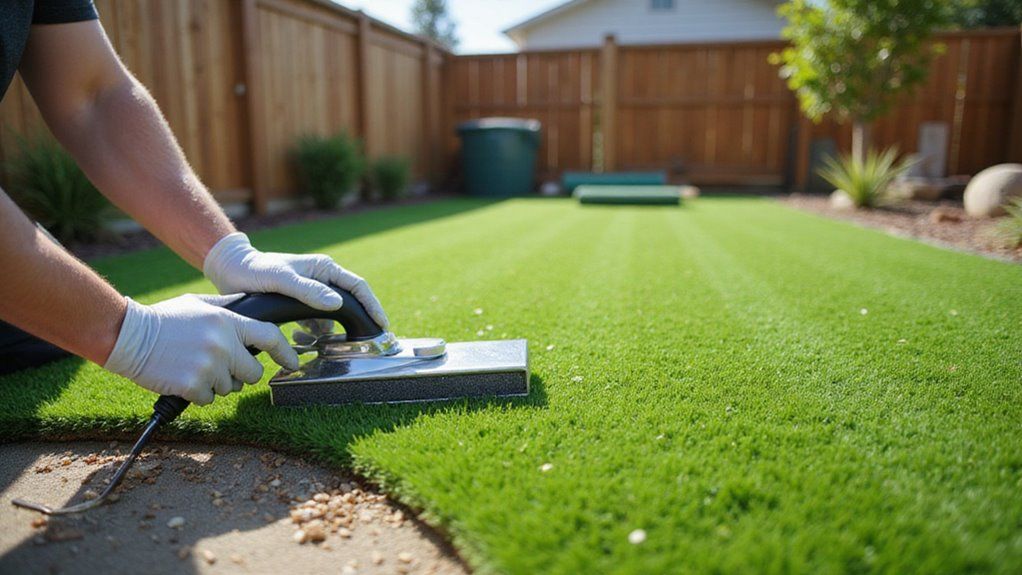
Struggling with endless lawn maintenance, homeowners across the country turn to artificial grass as their salvation. Weekend warriors waste countless hours mowing, watering, and fertilizing their natural lawns, while expenses keep mounting. Artificial turf offers a permanent solution, eliminating maintenance headaches and providing year-round green perfection.
The typical artificial grass installation takes 1-3 days for professional contractors on residential properties under 1,000 square feet. Larger yards exceeding 2,000 square feet require 3-4 days, while DIY installations generally take longer due to experience and equipment limitations.
In this guide, we’ll explore everything you need to know about artificial grass installation timelines and requirements.
Key Takeaways
- Professional installation typically takes 1-3 days, while DIY projects average 3-4 days for completion.
- Residential yards under 1,000 square feet are usually completed within 24-48 hours by experienced crews.
- Larger properties over 2,000 square feet may require 3-4 days depending on complexity and conditions.
- Installation time varies based on property size, drainage needs, surface conditions, and weather delays.
- Key stages include ground preparation (5-9 hours), base installation (4-8 hours), and turf laying (4-6 hours).
How long does artificial grass installation usually take?
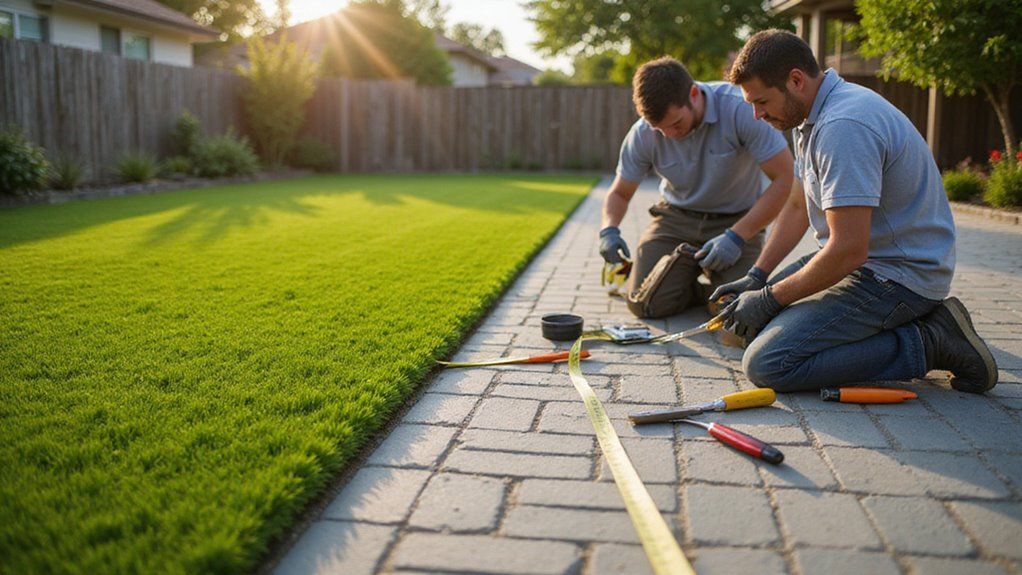
A typical artificial grass installation takes 1-3 days for professional crews to complete. Professional teams can finish most residential projects under 1,000 square feet in about 24-48 hours. Larger yards of 2,000+ square feet might need 3-4 days for proper installation.
The timeline depends on several key factors. Your yard’s condition and existing landscape will affect the schedule. Complex designs or special drainage needs can extend the project duration.
For DIY installations, homeowners should plan differently. A DIY project often requires 4-7 days to complete the same work. Weather conditions and ground preparation can impact the final timeline.
What factors affect artificial grass installation time?
Your artificial grass installation timeline depends on several measurable variables that directly impact labor hours and project completion. Property size, existing surface conditions, and mandatory drainage configurations determine the scope of site preparation—typically the most time-intensive phase.
Crew experience level and Florida’s unpredictable weather patterns, particularly afternoon thunderstorms, can extend a standard 1-3 day residential installation by 50% or more.
Property size and shape
Property size and shape determine installation complexity and time requirements for artificial grass projects. A standard rectangular lawn of 500 square feet needs 8-12 crew hours for installation. Complex layouts with curves or slopes can require up to 24 crew hours. Tight spaces and landscape features create additional challenges for installation teams.
Moreover, property access and edge details affect completion timelines. Projects over 1,000 square feet must follow Florida Building Code standards for drainage. Proper base preparation becomes essential for long-term success on larger properties.
Current surface conditions
Surface conditions range from concrete to natural grass, each requiring specific preparation methods.
Concrete surfaces need 4-8 hours of prep work per 500 square feet. Natural grass removal takes 2-4 hours for the same area. Heavy equipment becomes necessary for hard surface removal.
The terrain type greatly impacts installation timelines. Clay soil requires extra drainage work to meet building codes. Rocky ground needs extensive preparation. Uneven surfaces must undergo laser leveling. More importantly, proper surface preparation ensures long-lasting artificial turf installation.
Drainage requirements
Proper drainage prevents flooding and damage to artificial grass installations. A minimum slope of 2% away from structures ensures water flows correctly. Drains must be placed every 400 square feet to handle heavy rainfall.
Base layers require perforated pipes and gravel for effective water dispersal. French drains work well for areas with poor natural drainage. Local building codes often mandate specific drain placement and pipe sizes.
Beyond technical requirements, good drainage extends turf life and prevents mold growth. Annual maintenance keeps drain systems clear and functional. The initial investment in quality drainage pays off through reduced repair costs.
Weather conditions
Weather conditions directly impact synthetic turf installation timing and success. Active rainfall forces immediate work stoppage and requires postponement of all installation phases. Saturated ground needs 24-48 hours to dry before base preparation can begin.
High humidity extends adhesive curing times significantly. Extreme heat above 90°F requires early morning scheduling to protect materials and workers. During hurricane season, projects need extra buffer time for weather delays.
Smart contractors add 2-3 additional days to installation timelines during challenging weather periods. These precautions ensure quality results and protect investment value.
Crew size and experience
A standard artificial turf crew consists of 3-5 skilled workers. These professionals handle specialized tasks like base preparation, drainage, and seaming. Each team member brings unique expertise to ensure proper installation.
Crews with 5+ years of experience complete installations 30% faster than novice teams. Seasoned installers make fewer mistakes and work more efficiently. Their knowledge helps prevent common issues and reduces rework time.
Moreover, trained teams adapt better to challenging conditions and site requirements. Professional crews maintain high quality standards while meeting project timelines.
Complexity of design
Complex yard designs add significant time to artificial grass installation projects. Curved layouts and elevation changes extend installation time by 40-60% versus basic rectangular designs. Precise cuts and special seaming techniques require extra attention around pools and gardens. Multiple layers of preparation must meet strict building codes.
Professional installers need 1-2 extra days for complex projects. Do-it-yourself homeowners should plan for twice that duration. Proper drainage and edge finishing take additional care in detailed areas.
Throughout Florida, custom designs demand meticulous planning and execution. As a result, proper scheduling helps ensure quality results that satisfy code requirements.
How to prepare your yard for artificial grass installation?
You’ll need to start by removing all existing grass and vegetation down to the soil, ensuring a clean substrate for the base layer. Next, grade and compact the ground to create a level surface with proper slope—typically 2-3% grade—to direct water flow away from structures.
Finally, install your drainage system and secure perimeter edging before any turf goes down, as these foundational steps directly impact your project timeline and compliance with Florida Building Code requirements.
Removing existing grass and vegetation
A mechanical sod cutter removes existing grass in clean strips. Each strip should measure 12-18 inches wide for easy handling and disposal. Deep root extraction prevents future growth and soil settling issues.
Proper disposal requires 1-2 cubic yards of waste container space per 500 square feet of removed vegetation. A level grade ensures correct water drainage across the cleared area.
Moreover, complete vegetation removal protects new installations from contamination. The soil surface must maintain a 2% slope away from structures to meet standard drainage requirements.
Ground leveling and compaction
Ground leveling and compaction takes 4-6 hours for a 1,000-square-foot yard. Professional crews must achieve 90-95% compaction density using plate compactors or rollers. The ground needs a minimum 1% slope to meet Florida Building Code requirements.
Proper compaction prevents future settling issues and surface problems. Florida’s sandy soil requires crushed stone for a stable base. Rain delays can extend the installation timeline significantly.
Additionally, drainage systems need integration during this phase for optimal performance. A well-compacted foundation ensures your artificial turf stays level and functional for years.
Installing proper drainage system
A proper drainage system takes 2-3 days to install for an average residential yard.
The process requires digging trenches 6-8 inches deep across the installation area. A layer of crushed stone creates the foundation for water flow. The drainage slope must maintain a minimum 1% grade to prevent water pooling.
Professional installers place perforated pipes within the gravel base for optimal drainage. Florida Building Code compliance demands specific drainage requirements to avoid flooding issues. The right drainage setup ensures your artificial grass performs well for many years.
Edge installation and preparation
Edge installation secures the perimeter of your artificial turf space. Professional installers place flexible borders around walkways and garden areas to prevent grass movement. The process takes 2-4 hours for typical home yards.
Different edge materials offer various installation timeframes. Plastic bender board requires 2-3 hours, while metal edging needs 3-4 hours. Concrete mow strips take the longest at 4-6 hours to complete.
Moreover, proper edge installation creates clean surface transitions. These borders must meet Florida Building Code requirements for safety and durability. The right edging choice ensures your turf stays in place for years.
What’s the typical timeline for a DIY installation?
A complete DIY artificial turf installation takes 3-4 days on average. The timeline includes 1-2 days for site preparation, 1 day for base material work, 1-2 days for turf installation, and a half-day for finishing touches.
Weather conditions play a crucial role in the installation schedule. Rain, extreme heat, or high humidity can extend the timeline significantly. Professional preparation and proper tools help ensure efficient completion within this timeframe.
Moreover, your yard size and existing landscape complexity will affect the duration. A standard 500-square-foot yard typically fits within this timeline.
How does professional installation timeline compare to DIY?
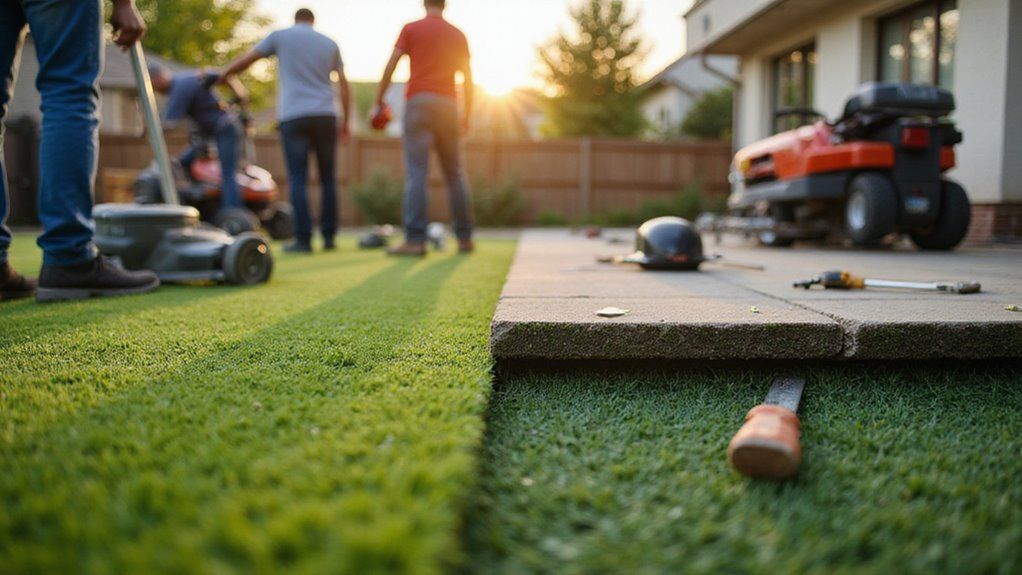
Professional installation takes 1-3 days, while DIY projects need 4-7 days to complete.
Licensed contractors can finish a 500-square-foot yard in 8-16 work hours. A DIY installer needs 24-32 hours for the same project. Professional crews use specialized equipment like plate compactors and seaming irons. Their teams work efficiently on multiple tasks at once.
Beyond timing differences, professionals deliver better results through experience and proper tools. Florida law requires contractors to meet Chapter 489 licensing standards. This ensures high-quality work with fewer weather delays or code issues.
What are the installation stages and their timeframes?
You’ll move through five distinct installation stages, each with specific time requirements that affect your total project duration.
Professional crews typically complete initial assessment and measurement in 1-2 hours, followed by ground preparation (4-8 hours), base material installation (4-6 hours), turf laying and securing (3-5 hours), and final trimming with finishing touches (2-3 hours).
Florida’s climate demands extra attention during base installation and adhesive curing, as heavy rain can extend these phases by 24-48 hours if drainage systems aren’t properly configured.
Initial assessment and measurement
Initial measurements and site evaluations take about 30-90 minutes before installation begins. A thorough assessment prevents problems and ensures proper planning.
Professional installers must check four key areas: water drainage patterns, soil conditions, physical obstacles, and exact measurements. Proper drainage evaluation helps meet Florida building requirements. The base preparation phase determines how much soil needs removal.
Clear documentation of sprinkler systems and tree roots prevents damage during installation. Meanwhile, precise square footage calculations ensure accurate material ordering. These careful preparations lead to proper permits and realistic project schedules.
Ground preparation phase
Ground preparation takes 5-9 hours total for a proper artificial grass installation.
The process requires three main tasks: vegetation removal (2-3 hours), soil compaction (1-2 hours), and drainage installation (2-4 hours). Each step demands specific attention to key factors for success.
Good weather conditions make the work efficient and reliable. The team must monitor soil moisture levels during compaction. Furthermore, proper drainage ensures long-term performance and prevents water pooling. Local building codes guide drainage system requirements for optimal results.
Base material installation
Base material installation takes 4-8 hours to complete. A standard installation requires 3-4 inches of crushed stone for proper drainage. Professional crews spread and level the material with laser-guided equipment. Final compaction must reach 90-95% density for long-term stability.
Proper moisture levels help achieve optimal compaction results. The process follows strict building codes for water management. Installation timing can extend during Florida’s rainy season due to weather delays.
Turf laying and securing
Professional crews lay and secure artificial turf in 4-6 hours total for most residential projects.
Teams start by unrolling turf sections across the prepared base within 2-4 hours. Precise seam alignment ensures a natural, uniform appearance. Stakes and nails anchor the perimeter securely in place.
After installation, workers apply infill material and power-broom the surface. The final steps add 1-2 hours to achieve proper drainage and blade orientation. In Florida’s humid climate, adhesive curing requires additional time for optimal results.
Final trimming and finishing touches
Final trim work and small adjustments create a polished, professional finish. Cut all edges precisely against hardscapes to prevent lifting or gaps. A thorough seam check ensures strong bonds across the entire surface.
Power brooming redistributes infill material for consistent coverage and proper blade support. Every completed installation must pass local drainage standards and receive inspector approval.
This meticulous attention to detail protects your investment and extends turf life. After completion, your new artificial lawn will look natural and perform flawlessly for years.
Can weather conditions delay your artificial grass installation?
YES, Weather conditions can significantly delay artificial grass installation.
Rain and moisture prevent proper base preparation and adhesive curing during installation. Professional installers typically add 2-3 weather delay days to project timelines. Wet ground needs adequate drying time before work can continue safely.
Weather impacts directly affect the quality and durability of artificial grass installations. The base must remain dry for proper compaction and drainage system setup. Smart scheduling and weather monitoring help minimize these delays while maintaining high-quality results.
Ready for your perfect lawn? Contact Synthetic Turf Treasure Coast today!
Professional turf installers save time and prevent costly mistakes. A licensed team completes installations 50-75% faster than DIY attempts. Their expertise ensures proper drainage and long-lasting results.
Each project follows Florida Building Code requirements for safety and durability. The installation process includes detailed site assessment and weather planning. Professional crews handle complex drainage integration correctly.
Better installations lead to reduced maintenance and fewer future repairs. A properly installed artificial lawn adds value to your property. Contact Synthetic Turf Treasure Coast for reliable installation services.
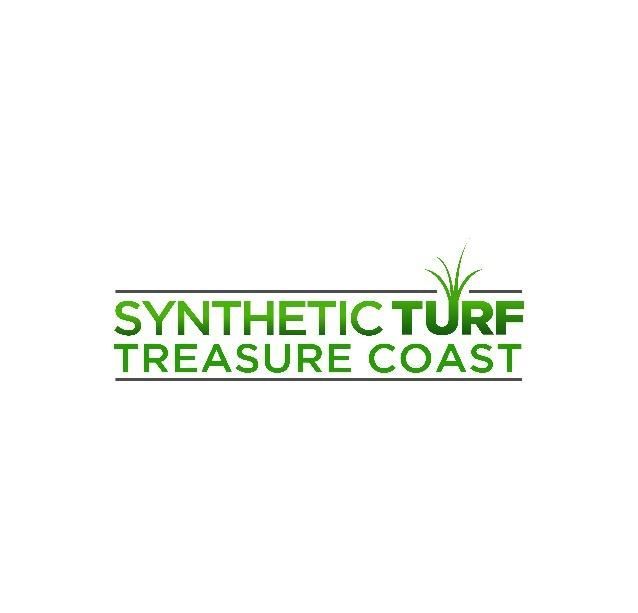
About the author
Kathy Leavell
Kathy Leavell is the founder and owner of Synthetic Turf Treasure Coast, a leading provider of synthetic grass solutions for residential and commercial properties in Florida. With over a decade of experience in the industry, Kathy has become a recognized expert in synthetic turf installation, maintenance, and repair. Under her leadership, Synthetic Turf Treasure Coast has earned a reputation for exceptional customer service and high-quality workmanship.
Prior to starting her own business, Kathy worked in sales and marketing roles at several major synthetic turf manufacturers.
